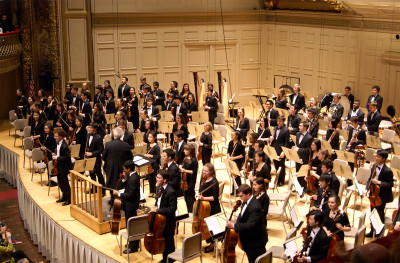
Orchestral music is hardly considered the sound of today’s youth, but the Boston Philharmonic Youth Orchestra is shaking up that image.
The orchestra’s free concert Monday night challenged preconceived notions of what a youth orchestra can achieve, especially when it is limited to only practicing on Saturdays. The musicians ranged from ages 12 to 21, but played with the concentration and ability of musicians double their ages.
The line for the performance went around the block and the comments of those waiting mostly expressed shock at the number of people. One woman asked incredulously, “How could a youth orchestra sell out Symphony Hall?” The music was the likely answer — the orchestra tackled the sophisticated works of Glinka, Stravinsky, Debussy and Tchaikovsky.
Benjamin Zander, the conductor of the Boston Philharmonic Youth Orchestra, was clearly a force to be reckoned with. He radiated energy and his passion was clearly the backbone of the Youth Orchestra, galvanizing support for the effort and driving the players forward with his energy.
Zander has the members of his orchestra fill out weekly “white sheets,” which invite them to reflect on their leadership abilities and other aspects of their lives. He blazed onto the stage Monday night and had the audience giggling with his passionate descriptions of the pieces he was going to conduct, at one point merely emphasizing “OMG” when describing Debussy’s “La Mer.”
The music was refined for an orchestra of such young players, and Zander carried them through it with his intensely physical conducting.
Ayano Ninomiya was featured on Stravinsky’s Violin Concerto, playing with such electrifying passion that she almost vibrated along with her bow, moving her entire body into the music as she played. She played the violin growing up in a Boston public school and she went on to Harvard University and The Julliard School.
“Stravinsky wants refinement,” Zander said to the audience, and refinement was what Ninomiya delivered. It was gorgeous and mesmerizing to watch her play the piece.
While Ninomiya was on stage, the entirety of Symphony Hall leaned towards her, raptly attentive. And when she stepped off and La Mer commenced, the audience missed her onstage presence.
Listeners discussed the La Mer performance during intermission and one woman in particular informed those in her vicinity, “Zander should have sculpted the wave of the music.” However, the lulls and the swells of the music were lovely to listen to and did resemble the tides of the ocean and the different flows of water.
Later in the performance, during the crescendo of Tchaikovsky’s Symphony No. 5, a woman dozed off next to me, her head drooping. This certainly was not a testament to the ability of the players to mimic the soothing sound of the ocean.
The piece dragged on. It would have been a better choice to finish with Ninomiya’s piece rather than to begin with it and set the audience up for the disappointment of losing her from the stage.
In the end, though, it was a beautiful performance and a testament to the ability of the players that they managed to tackle such complex works as Tchaikovsky’s fifth. The music filled the halls and was a credit to Zander’s ability as a conductor as well as to the skill of those who played.
Although the Boston Philharmonic Youth Orchestra was only formed in 2012, they have blazed their way through the musical world and to hear them is to feel wonder at the music such young musicians can produce.
















































































































